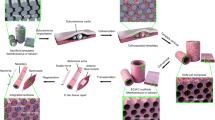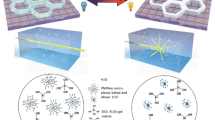Abstract
The field of tissue engineering and regenerative medicine will tremendously benefit from the development of three dimensional scaffolds with defined micro- and macro-architecture that replicate the geometry and chemical composition of native tissues. The current report describes a freeform fabrication technique that permits the development of nerve regeneration scaffolds with precisely engineered architecture that mimics that of native nerve, using the native extracellular matrix component hyaluronic acid (HA). To demonstrate the flexibility of the fabrication system, scaffolds exhibiting different geometries with varying pore shapes, sizes and controlled degradability were fabricated in a layer-by-layer fashion. To promote cell adhesion, scaffolds were covalently functionalized with laminin. This approach offers tremendous spatio-temporal flexibility to create architecturally complex structures such as scaffolds with branched tubes to mimic branched nerves at a plexus. We further demonstrate the ability to create bidirectional gradients within the microfabricated nerve conduits. We believe that combining the biological properties of HA with precise three dimensional micro-architecture could offer a useful platform for the development of a wide range of bioartificial organs.








Similar content being viewed by others
References
B. Agerup, P. Berg et al., Non-animal stabilized hyaluronic acid: a new formulation for the treatment of osteoarthritis. BioDrugs 19(1), 23–30 (2005)
J.S. Belkas, M.S. Shoichet et al., Peripheral nerve regeneration through guidance tubes. Neurol. Res. 26(2), 151–160 (2004)
R.V. Bellamkonda, Peripheral nerve regeneration: an opinion on channels, scaffolds and anisotropy. Biomaterials 27(19), 3515–3518 (2006)
L. Cen, K.G. Neoh et al., Surface functionalization of electrically conductive polypyrrole film with hyaluronic acid. Langmuir 18(22), 8633–8640 (2002)
W.Y. Chen, G. Abatangelo, Functions of hyaluronan in wound repair. Wound Repair Regen. 7(2), 79–89 (1999)
F.M. Chen, M. Zhang et al., Toward delivery of multiple growth factors in tissue engineering. Biomaterials 31(24), 6279–6308 (2010)
J.H. Collier, J.P. Camp et al., Synthesis and characterization of polypyrrole-hyaluronic acid composite biomaterials for tissue engineering applications. J. Biomed. Mater. Res. 50(4), 574–584 (2000)
C. Fieber, R. Plug et al., Characterisation of the murine gene encoding the intracellular hyaluronan receptor IHABP (RHAMM). Gene 226(1), 41–50 (1999)
J.L. Goldberg, B.A. Barres, The relationship between neuronal survival and regeneration. Annu. Rev. Neurosci. 23, 579–612 (2000)
R.W. Gundersen, J.N. Barrett, Neuronal chemotaxis: chick dorsal-root axons turn toward high concentrations of nerve growth factor. Science 206(4422), 1079–1080 (1979)
L. Han, G. Mapili et al., Freeform fabrication of biological scaffolds by projection photopolymerization. J. Manuf. Sci. Eng. 130(2), 021005 (2008)
S.J. Hollister, Porous scaffold design for tissue engineering. Nat. Mater. 4(7), 518–524 (2005)
K. Ikeda, D. Yamauchi et al., Hyaluronic acid prevents peripheral nerve adhesion. Br. J. Plast. Surg. 56(4), 342–347 (2003)
D. Jiang, J. Liang et al., Hyaluronan in tissue injury and repair. Annu. Rev. Cell Dev. Biol. 23, 435–461 (2007)
I. Junarsa, P.F. Nealey, Fabrication of masters for nanoimprint, step and flash, and soft lithography using hydrogen silsesquioxane and x-ray lithography. J. Vac. Sci. Technol. B 22(6), 2685–2690 (2004)
T.A. Kapur, M.S. Shoichet, Immobilized concentration gradients of nerve growth factor guide neurite outgrowth. J. Biomed. Mater. Res. A 68(2), 235–243 (2004)
N. Kleitman, P.M. Wood et al., Tissue culture methods for the study of myelination (MIT, Massachusetts, 1991)
J.B. Leach, C.E. Schmidt, Hyaluronan, in Encyclopedia of biomaterials and biomedical engineering, ed. by G.E. Wnek, G.L. Bowlin (Marcel Dekker, New York, 2004), pp. 779–789
S.M. Lee, E. Pippel et al., Greatly increased toughness of infiltrated spider silk. Science 324(5926), 488–492 (2009)
Y. Lu, G. Mapili et al., A digital micro-mirror device-based system for the microfabrication of complex, spatially patterned tissue engineering scaffolds. J. Biomed. Mater. Res. 77A(2), 396–405 (2006)
M.J. Mondrinos, R. Dembzynski et al., Porogen-based solid freeform fabrication of polycaprolactone-calcium phosphate scaffolds for tissue engineering. Biomaterials 27(25), 4399–4408 (2006)
G.Y. Ozgenel, Effects of hyaluronic acid on peripheral nerve scarring and regeneration in rats. Microsurgery 23(6), 575–581 (2003)
E. Sachlos, J.T. Czernuszka, Making tissue engineering scaffolds work. Review: the application of solid freeform fabrication technology to the production of tissue engineering scaffolds. Eur. Cell. Mater. 5, 29–39 (2003). discussion 39–40
C.E. Schmidt, J.B. Leach, Neural tissue engineering: strategies for repair and regeneration. Annu. Rev. Biomed. Eng. 5, 293–347 (2003)
M. Slevin, S. Kumar et al., Angiogenic oligosaccharides of hyaluronan induce multiple signaling pathways affecting vascular endothelial cell mitogenic and wound healing responses. J. Biol. Chem. 277(43), 41046–41059 (2002)
B. Strauch, Use of nerve conduits in peripheral nerve repair. Hand Clin. 16(1), 123–130 (2000)
S. Suri, C.E. Schmidt, Photopatterned collagen-hyaluronic acid interpenetrating polymer network hydrogels. Acta Biomater. 5(7), 2385–2397 (2009)
H.S. Yoo, E.A. Lee et al., Hyaluronic acid modified biodegradable scaffolds for cartilage tissue engineering. Biomaterials 26(14), 1925–1933 (2005)
Acknowledgements
We gratefully acknowledge support from a NIH EB003416 to CES and SC. The authors would also like to thank the Schmidt and Chen lab members for useful discussions.
Author information
Authors and Affiliations
Corresponding authors
Rights and permissions
About this article
Cite this article
Suri, S., Han, LH., Zhang, W. et al. Solid freeform fabrication of designer scaffolds of hyaluronic acid for nerve tissue engineering. Biomed Microdevices 13, 983–993 (2011). https://doi.org/10.1007/s10544-011-9568-9
Published:
Issue Date:
DOI: https://doi.org/10.1007/s10544-011-9568-9




